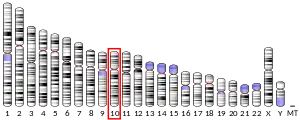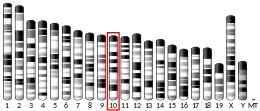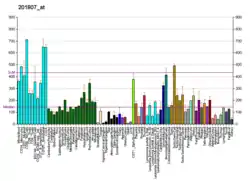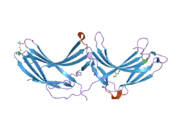VPS26A
Vacuolar protein sorting-associated protein 26A is a protein that in humans is encoded by the VPS26A gene.[5][6][7]
| VPS26A | |||||||||||||||||||||||||||||||||||||||||||||||||||
|---|---|---|---|---|---|---|---|---|---|---|---|---|---|---|---|---|---|---|---|---|---|---|---|---|---|---|---|---|---|---|---|---|---|---|---|---|---|---|---|---|---|---|---|---|---|---|---|---|---|---|---|
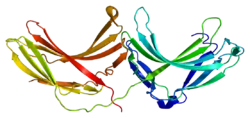 | |||||||||||||||||||||||||||||||||||||||||||||||||||
| |||||||||||||||||||||||||||||||||||||||||||||||||||
| Identifiers | |||||||||||||||||||||||||||||||||||||||||||||||||||
| Aliases | VPS26A, HB58, Hbeta58, PEP8A, VPS26, VPS26 retromer complex component A, VPS26, retromer complex component A | ||||||||||||||||||||||||||||||||||||||||||||||||||
| External IDs | OMIM: 605506 MGI: 1353654 HomoloGene: 68420 GeneCards: VPS26A | ||||||||||||||||||||||||||||||||||||||||||||||||||
| |||||||||||||||||||||||||||||||||||||||||||||||||||
| |||||||||||||||||||||||||||||||||||||||||||||||||||
| |||||||||||||||||||||||||||||||||||||||||||||||||||
| |||||||||||||||||||||||||||||||||||||||||||||||||||
| |||||||||||||||||||||||||||||||||||||||||||||||||||
| Wikidata | |||||||||||||||||||||||||||||||||||||||||||||||||||
| |||||||||||||||||||||||||||||||||||||||||||||||||||
This gene belongs to a group of vacuolar protein sorting (VPS) genes. The encoded protein is a component of a large multimeric complex, termed the retromer complex, involved in retrograde transport of proteins from endosomes to the trans-Golgi network. The close structural similarity between the yeast and human proteins that make up this complex suggests a similarity in function. Expression studies in yeast and mammalian cells indicate that this protein interacts directly with VPS35, which serves as the core of the retromer complex. Alternative splicing results in multiple transcript variants encoding different isoforms.[7]
Structure
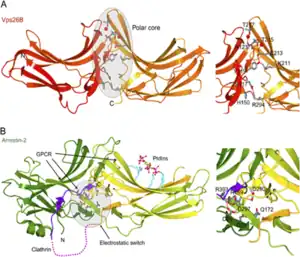
Vps26 is a 38-kDa subunit that has a two-lobed structure with a polar core that resembles the arrestin family of trafficking adaptor.[8][9] This fold consist of two related β-sandwich subdomains with a fibronectin type III domain topology. The two domains are joined together by a flexible linker and are closely associated by an unusual polar core. Arrestins are regulatory proteins known for connecting G-protein coupled receptors (GPCRs) to clathrin during endocytosis. They play many critical roles in cell signalling and membrane trafficking.[10] Both Vps26 and arrestins are composed of two structurally related β-sheet domains forming extensive interfaces with each other, using polar and electrostatic contacts to create interdomain interactions for ligand binding. However, there are significant structural differences between both Vps26 and arrestins. Vps26 protein has extended C-terminal tails that do not contain identifiable clathrin- or AP2-binding sequences, and therefore cannot form stable intramolecular contacts with clathrin and AP2, which has been observed for arrestins. Moreover, Vps26 does not have similar sequences as arrestins for GPCR and phospholipid interactions.[11]
Vps26B paralogue
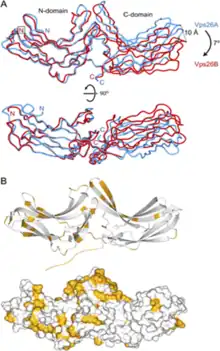
In yeast, there is only one Vps26 species, whereas there are two Vps26 paralogues (Vps26A and Vps26B) in mammals.[12]
X-ray crystallography revealed that the structures of both Vps26A and Vps26B share a similar bilobal β-sandwich structure and possess 70% sequence homology.[8] However, these two paralogues distinctly differ on the surface patch within the N-terminal domain, the apex region where the N-terminal and C-terminal domains meet and the disordered C-terminal tail. Vps26B contains several putative serine phosphorylation residues within this disordered tail, which may represent a potential mechanism to modulate the difference between Vps26A and Vps26B. A recent study conducted by Bugarcic et al. pinpointed that this disordered tail on C-terminal region of Vps26B is one of the underlying factors that contributes to the failure for Vps26B-containing Retromer to associate with CI-M6PR, ultimately leading to CI-M6PR degradation, accompanied with increased cathepsin D secretion.[13]
References
- GRCh38: Ensembl release 89: ENSG00000122958 - Ensembl, May 2017
- GRCm38: Ensembl release 89: ENSMUSG00000020078 - Ensembl, May 2017
- "Human PubMed Reference:". National Center for Biotechnology Information, U.S. National Library of Medicine.
- "Mouse PubMed Reference:". National Center for Biotechnology Information, U.S. National Library of Medicine.
- Lee JJ, Radice G, Perkins CP, Costantini F (Aug 1992). "Identification and characterization of a novel, evolutionarily conserved gene disrupted by the murine H beta 58 embryonic lethal transgene insertion". Development. 115 (1): 277–88. doi:10.1242/dev.115.1.277. PMID 1638986.
- Mao M, Fu G, Wu JS, Zhang QH, Zhou J, Kan LX, Huang QH, He KL, Gu BW, Han ZG, Shen Y, Gu J, Yu YP, Xu SH, Wang YX, Chen SJ, Chen Z (Aug 1998). "Identification of genes expressed in human CD34+ hematopoietic stem/progenitor cells by expressed sequence tags and efficient full-length cDNA cloning". Proc Natl Acad Sci U S A. 95 (14): 8175–80. doi:10.1073/pnas.95.14.8175. PMC 20949. PMID 9653160.
- "Entrez Gene: VPS26A vacuolar protein sorting 26 homolog A (S. pombe)".
- Collins BM, Norwood SJ, Kerr MC, Mahony D, Seaman MN, Teasdale RD, Owen DJ (March 2008). "Structure of Vps26B and mapping of its interaction with the retromer protein complex". Traffic. 9 (3): 366–79. doi:10.1111/j.1600-0854.2007.00688.x. PMID 18088321. S2CID 37113942.
- Shi H, Rojas R, Bonifacino JS, Hurley JH (June 2006). "The retromer subunit Vps26 has an arrestin fold and binds Vps35 through its C-terminal domain". Nat. Struct. Mol. Biol. 13 (6): 540–8. doi:10.1038/nsmb1103. PMC 1584284. PMID 16732284.
- Gurevich VV, Gurevich EV (June 2006). "The structural basis of arrestin-mediated regulation of G-protein-coupled receptors". Pharmacol. Ther. 110 (3): 465–502. doi:10.1016/j.pharmthera.2005.09.008. PMC 2562282. PMID 16460808.
- Collins BM (November 2008). "The structure and function of the retromer protein complex". Traffic. 9 (11): 1811–22. doi:10.1111/j.1600-0854.2008.00777.x. PMID 18541005. S2CID 28028098.
- Kerr MC, Bennetts JS, Simpson F, Thomas EC, Flegg C, Gleeson PA, Wicking C, Teasdale RD (November 2005). "A novel mammalian retromer component, Vps26B". Traffic. 6 (11): 991–1001. doi:10.1111/j.1600-0854.2005.00328.x. PMID 16190980. S2CID 31954489.
- Bugarcic A, Zhe Y, Kerr MC, Griffin J, Collins BM, Teasdale RD (December 2011). "Vps26A and Vps26B subunits define distinct retromer complexes". Traffic. 12 (12): 1759–73. doi:10.1111/j.1600-0854.2011.01284.x. PMID 21920005. S2CID 24548200.
Further reading
- Zhang QH, Ye M, Wu XY, et al. (2001). "Cloning and Functional Analysis of cDNAs with Open Reading Frames for 300 Previously Undefined Genes Expressed in CD34+ Hematopoietic Stem/Progenitor Cells". Genome Res. 10 (10): 1546–60. doi:10.1101/gr.140200. PMC 310934. PMID 11042152.
- Haft CR, de la Luz Sierra M, Bafford R, et al. (2001). "Human Orthologs of Yeast Vacuolar Protein Sorting Proteins Vps26, 29, and 35: Assembly into Multimeric Complexes". Mol. Biol. Cell. 11 (12): 4105–16. doi:10.1091/mbc.11.12.4105. PMC 15060. PMID 11102511.
- Reddy JV, Seaman MN (2002). "Vps26p, a Component of Retromer, Directs the Interactions of Vps35p in Endosome-to-Golgi Retrieval". Mol. Biol. Cell. 12 (10): 3242–56. doi:10.1091/mbc.12.10.3242. PMC 60170. PMID 11598206.
- Strausberg RL, Feingold EA, Grouse LH, et al. (2003). "Generation and initial analysis of more than 15,000 full-length human and mouse cDNA sequences". Proc. Natl. Acad. Sci. U.S.A. 99 (26): 16899–903. Bibcode:2002PNAS...9916899M. doi:10.1073/pnas.242603899. PMC 139241. PMID 12477932.
- Ota T, Suzuki Y, Nishikawa T, et al. (2004). "Complete sequencing and characterization of 21,243 full-length human cDNAs". Nat. Genet. 36 (1): 40–5. doi:10.1038/ng1285. PMID 14702039.
- Deloukas P, Earthrowl ME, Grafham DV, et al. (2004). "The DNA sequence and comparative analysis of human chromosome 10". Nature. 429 (6990): 375–81. Bibcode:2004Natur.429..375D. doi:10.1038/nature02462. PMID 15164054.
- Vergés M, Luton F, Gruber C, et al. (2004). "The mammalian retromer regulates transcytosis of the polymeric immunoglobulin receptor". Nat. Cell Biol. 6 (8): 763–9. doi:10.1038/ncb1153. PMID 15247922. S2CID 22296469.
- Mingot JM, Bohnsack MT, Jäkle U, Görlich D (2005). "Exportin 7 defines a novel general nuclear export pathway". EMBO J. 23 (16): 3227–36. doi:10.1038/sj.emboj.7600338. PMC 514512. PMID 15282546.
- Gerhard DS, Wagner L, Feingold EA, et al. (2004). "The Status, Quality, and Expansion of the NIH Full-Length cDNA Project: The Mammalian Gene Collection (MGC)". Genome Res. 14 (10B): 2121–7. doi:10.1101/gr.2596504. PMC 528928. PMID 15489334.
- Kerr MC, Bennetts JS, Simpson F, et al. (2006). "A novel mammalian retromer component, Vps26B". Traffic. 6 (11): 991–1001. doi:10.1111/j.1600-0854.2005.00328.x. PMID 16190980. S2CID 31954489.
- Small SA, Kent K, Pierce A, et al. (2006). "Model-guided microarray implicates the retromer complex in Alzheimer's disease". Ann. Neurol. 58 (6): 909–19. doi:10.1002/ana.20667. PMID 16315276. S2CID 34144181.
- Gullapalli A, Wolfe BL, Griffin CT, et al. (2006). "An Essential Role for SNX1 in Lysosomal Sorting of Protease-activated Receptor-1: Evidence for Retromer-, Hrs-, and Tsg101-independent Functions of Sorting Nexins". Mol. Biol. Cell. 17 (3): 1228–38. doi:10.1091/mbc.E05-09-0899. PMC 1382312. PMID 16407403.
- Shi H, Rojas R, Bonifacino JS, Hurley JH (2006). "The retromer subunit Vps26 has an arrestin fold and binds Vps35 through its C-terminal domain". Nat. Struct. Mol. Biol. 13 (6): 540–8. doi:10.1038/nsmb1103. PMC 1584284. PMID 16732284.
- Riemenschneider M, Schoepfer-Wendels A, Friedrich P, et al. (2007). "No association of vacuolar protein sorting 26 polymorphisms with Alzheimer's disease". Neurobiol. Aging. 28 (6): 883–4. doi:10.1016/j.neurobiolaging.2006.05.009. PMID 16784798. S2CID 20057417.
- Rojas R, Kametaka S, Haft CR, Bonifacino JS (2007). "Interchangeable but Essential Functions of SNX1 and SNX2 in the Association of Retromer with Endosomes and the Trafficking of Mannose 6-Phosphate Receptors". Mol. Cell. Biol. 27 (3): 1112–24. doi:10.1128/MCB.00156-06. PMC 1800681. PMID 17101778.
